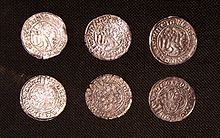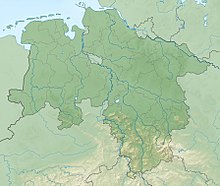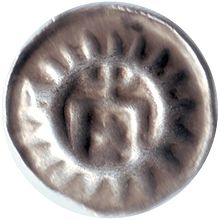Coin find from Northeim-Höckelheim
Coordinates: 51 ° 42 '8.4 " N , 9 ° 57' 49.1" E
The coin find from Northeim – Höckelheim consists of over 17,000 coins from the 13th, 14th and 15th centuries. It is considered to be the largest surviving coin find from the late Middle Ages in northern Germany and one of the largest in Germany.
Location and owner

During construction work on a gas pipeline in the Höckelheim district of Northeim in Lower Saxony , workers discovered a broken clay pot on December 3, 1991. The hastily summoned city archaeologist Günter Merl realized that the vessel had been used to bury coins. He initially hid the find in plastic bags. The coins were badly stuck together and corroded when they were found. After they were handed over to the Braunschweigisches Landesmuseum , they were restored, preserved and scientifically evaluated there.
Usually there is no written evidence of their composition (accumulation of the treasure) and deposit (securing of the treasure) in hoard finds . Therefore nothing is known about the owner or owners of the treasure. The size and composition of the treasure, however, indicate the possession of a wealthy family rather than supra-regional commercial activity. Securing assets by burying the treasure in a vessel was quite a common practice in a time without banking. The reason for this approach was often the fear of marauding mercenaries in times of war. This indicates a possible connection between the deposit of the treasure and the Battle of Höckelheim in 1545. The fact that the treasure was not recovered suggests that the owner or even the whole family did not have the opportunity to do so due to death.
Find content
The find contains, among other things, 122 Meissnian-Saxon groschen . These coins, minted on both sides, represent a special feature of the find insofar as most silver coins are hollow pennies minted on one side .
Due to the annual revocation of coins on St. Aegidien Day (September 1st), new mints were constantly necessary. This usually went hand in hand with a reduction in the fineness of the coins. The hoard thus also represents a constant material value. In addition, an indirect tax profit was achieved through a lower exchange value (around four old pennies for three new ones). Coinages were usually with a motif provided to distinguish the coins. With this coin find, a number of stamp variants could be proven for the first time, which explains the scientific value of the hoard.
Another special feature of the find are the two silver bars that were minted in Braunschweig before 1382, which can be read from their stamps. They do not yet contain a crown as a guarantee mark. This was only used after the Currency Treaty of July 29, 1382. The cities of Braunschweig, Goslar , Hildesheim, Einbeck , Hanover, Wernigerode and Osterode wanted to grant the same fineness of their bar money through this contract. Later, Göttingen , Hameln , Halberstadt , Quedlinburg and Aschersleben also joined this contract .
There was only one Northeim coin in the hoard. The other minting locations are in the order of their frequency: Braunschweig , Hanover , Hildesheim , Göttingen , Freiberg , Nordhausen (questionable), Halberstadt , Salzwedel (questionable), Lüneburg (questionable), Ellrich , Stolberg (Harz) , Gandersheim and Hamburg . In total, coins from over 40 minting locations were identified. About 70% of the coins are Braunschweig lion pennies and sheerfeeds from the 14th century.
exhibition
The find has been on display in the vaulted cellar of the Northeim Local History Museum since May 17, 2004. The conception of the exhibition was carried out by Gerd Biegel (then director of the Braunschweigisches Landesmuseum ), Silke Buchhagen (museum director) and Josef F. Fischer ( numismatist at the Braunschweigisches Landesmuseum).
See also
- Hilmar von Münchhausen on the battle of Höckelheim
- Medieval coins
literature
- Günter Merl: An important coin find in Northeim-Höckelheim , in: Northeimer Jahrbuch , Northeim 1992, ISSN 0936-8345 , pp. 47-49
- Gerd Biegel: The coin find from Northeim – Höckelheim - a consequence of the battle of Höckelheim in 1545? , in: Calendar 2003 , Braunschweigisches Landesmuseum, Braunschweig 2002, ISBN 3-927939-64-1 , pp. 20–32
- Silke Buchhagen: From the earth to the cellar - The Höckelheim coin find in a museum with a new face , in: Northeimer Jahrbuch , Northeim 1992, ISSN 0936-8345 , pp. 7-14
- Josef F. Fischer: The late medieval coin find from Northeim-Höckelheim (Lower Saxony) , 2005, in: XIII Congreso Internacional de Numismática , Madrid 2003. Actas - Proceedings - Actes Pt. 2 p. 1327-1336
Individual evidence
- ↑ Karola Hoffmann: Vessels from the Middle Ages, Shards from the Stone Age , in: Göttinger Tageblatt of August 17, 2007, also online (accessed April 1, 2010).
- ^ Günter Merle: The sensational coin find from Northeim-Höckelheim , p. 47f.
- ^ Gerd Biegel, The coin find from Northeim – Höckelheim - a consequence of the Battle of Höckelheim in 1545? , P. 31
- ^ Gerd Biegel, The coin find from Northeim – Höckelheim - a consequence of the Battle of Höckelheim in 1545? , P. 27
- ^ Gerd Biegel, The coin find from Northeim – Höckelheim - a consequence of the Battle of Höckelheim in 1545? , P. 28
- ^ Gerd Biegel, The coin find from Northeim – Höckelheim - a consequence of the Battle of Höckelheim in 1545? , P. 20
- ^ Silke Buchhagen: The coin find from Northeim-Höckelheim , flyer of the local history museum of the city of Northeim published by the mayor of the city of Northeim, no year


